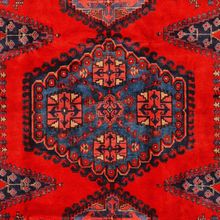Difference between revisions of "Viss Rug"
| Line 35: | Line 35: | ||
|additional info = | |additional info = | ||
}} | }} | ||
| − | + | Viss rugs originate from Viss, also referred to as Viss, a small town located near Hamadan. However, for a small town, Viss has an eclectic mix of population. Kurds, Turks, and the nomadic people of Bakhtiari all call Viss home, and it is the influence from these diverse groups that is an integral part of the weaving of wool rugs here. Due to its largely nomadic population, the majority of Viss rugs feature geometric designs, which is an indication of a tribal rug. Its location so close to Hamadan has influenced the local weavers to create their wool rugs using the Hamadan weave, also referred to as the Sennah Baft. These wool rugs are woven with a Turkish symmetrical knot and a single shot of weft between the rows of knots. | |
<!-- from Rugman Archive:https://web.archive.org/web/20070613055700/http://www.rugman.com:80/Content/wiss.html--> | <!-- from Rugman Archive:https://web.archive.org/web/20070613055700/http://www.rugman.com:80/Content/wiss.html--> | ||
Revision as of 09:01, 17 August 2020
| Viss Rug | |
|---|---|
 Design of Viss Rug (Rugman) | |
| General information | |
| Name | Viss Rug |
| Original name | قالي ویست |
| Alternative name(s) | Viss Carpet |
| Origin | |
| Category | Village |
| Technical information | |
| Common designs | Geometric, Herati, Boteh |
| Common colors | Red, Beige, Blue, Navy Blue |
| Dyeing method | Natural, Synthetic |
| Pile material | Wool |
| Foundation material | Cotton |
| Knot type | Symmetrical (Turkish) |
Viss rugs originate from Viss, also referred to as Viss, a small town located near Hamadan. However, for a small town, Viss has an eclectic mix of population. Kurds, Turks, and the nomadic people of Bakhtiari all call Viss home, and it is the influence from these diverse groups that is an integral part of the weaving of wool rugs here. Due to its largely nomadic population, the majority of Viss rugs feature geometric designs, which is an indication of a tribal rug. Its location so close to Hamadan has influenced the local weavers to create their wool rugs using the Hamadan weave, also referred to as the Sennah Baft. These wool rugs are woven with a Turkish symmetrical knot and a single shot of weft between the rows of knots.
History
Viss is a village located in the Markazi Province of central Iran. Viss carpets are known in the market from the second quarter of the twentieth century. They were popular in Europe as one of the few geometric room-size types with tribal design elements. These carpets were an alternative choice to the Heriz weavings of northwestern Iran, which were in demand by the world floor covering markets.
Viss carpets have a medallion style with stylized motifs generally in an Open Field design. The field has one, two, or three lozenge-shaped or hexagonal medallions along the length of the carpet. Tribal motifs of flower heads, Hook motifs, S motifs, animals, and birds may be added to the background. Decorative hook motifs edge the medallions and corners. In addition, rows of tulips, zigzag lines, or hooks can be found along the borders surrounding the field. The main border generally has alternating large leaves and vines with flower heads.
Viss field and border colors are mostly reds, dark blue, and ivory. Additionally, different shades of blue, green, brown, coral, gray, and gold appear in the medallions, design elements, and outlines.
The carpets have a cotton foundation and a wool pile. The Persian (asymmetric) knot is used. Viss sizes are made from approximately seven feet by four feet six inches to eighteen feet by twelve feet. Some runners and gallery formats were produced in a variety of lengths. Viss weavings are generally woven in grade qualities of medium to good.
By the last quarter of the twentieth century, some Viss weavers switched from traditional designs and made carpets and rugs similar to other neighboring areas according to the demand of domestic and foreign consumers.[1]
See also
References
- ↑ Moheban, 2015, 607-608
Bibliography
- Abraham Levi Moheban. 2015. The Encyclopedia of Antique Carpets: Twenty-Five Centuries of Weaving. NewYork: Princeton Architectural Press.